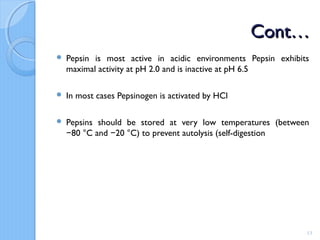Protease enzymes
- 1. Proteolytic EnzymesProteolytic Enzymes Prof. Harshraj. S. Shinde K. K. Wagh College of Agril. Biotech, Nashik. India
- 2. Proteolytic EnzymesProteolytic Enzymes Enzymes involved in degradation of proteins are called as proteases or proteolytic enzymes Industrially available proteolytic enzymes produced by microorganisms are usually mixtures of endopeptidases and exopeptidases. Proteins Polypeptides Polypeptides amino acids 2 Endopeptidases Exopeptidases
- 3. Cont …Cont … Because of the complex structures and high molecular weights of proteins enzymic proteolysis is extremely complicated. Most proteases are quite specific with regard to which peptide linkages they can split 3
- 4. List of proteolytic enzymesList of proteolytic enzymes a. Papain b. Ficain c. Bromelain d. Pepsin e. Rennin f. Cathepsin g. Trypsin 4
- 5. A) Papain ◦ Found in papaya ◦ papain, also known as papaya proteinase I ◦ Broad pH (3-11) and temperature stability For this reason very popular for a variety of food applications. 1. Used as a meat tenderizer on inferior meat cuts (can also use slice of pineapple on meat) The enzyme makes its way into the muscle and hydrolyzes primarily connective tissue proteins (collagen etc.) and softens muscle Have to use low amount to prevent liquefaction of muscle If you mix raw papaya into Jell-O it will not form a gel
- 6. Application of papainApplication of papain MeatTenderizer- Papain ( a protease found in papaya) is used as meat tenderizer to soften meat for cooking
- 7. Cont…Cont… Papain can be used to dissociate cells in the first step of cell culture preparations. 7
- 8. FicainFicain Ficain also known as ficin is an enzyme that is derived from figs latex It is of a family of proteases known as the cysteine endopeptidases It is one of the most commonly used for differentiating many blood group antigens 8
- 9. BromelainBromelain Bromelain is an enzyme generally found in the stems and fruits of pineapples. According their sources enzymes are divided into A. Stem bromelain. B. Fruit bromelain. The proteolytic enzymes are sulfhydryl proteases, since a free sulfhydryl group of a cysteine side chain is required for function 9
- 10. Bromelain is present in all parts of the pineapple plant but the stem is the most common commercial source 10
- 11. Applications of bromelainApplications of bromelain Along with papain, bromelain is one of the most popular proteases to use for meat tenderizinguse for meat tenderizing Cooked pineapple does not have a tenderizing effect, as the enzymes are heat-labile Preparation of meat ballsPreparation of meat balls Systemic enzyme therapy (combinations of proteolytic enzymes such as bromelain, trypsin and papain) has been used in the treatment of breast cancertreatment of breast cancer 11
- 12. PepsinPepsin Pepsin is an enzyme whose zymogen (pepsinogen) is released by the chief cellschief cells in the stomach and that degrades food proteins into peptides It was discovered by Theodor Schwann who also coined its name from the Greek word pepsis, meaning "digestion Pepsin is one of three principal protein-degrading enzyme in the digestive system, the other two being chymotrypsin and trypsin Pepsin is most efficient in cleaving peptide bonds and preferably breaks at aromatic amino acids such as phenylalanine, tryptophan, and tyrosine 12
- 13. Cont…Cont… Pepsin is most active in acidic environments Pepsin exhibits maximal activity at pH 2.0 and is inactive at pH 6.5 In most cases Pepsinogen is activated by HCl Pepsins should be stored at very low temperatures (between 80 °C and 20 °C) to prevent autolysis (self-digestion− − 13
- 14. Applications of pepsinApplications of pepsin Pepsin is commonly used in the preparation of F(ab')2 fragments from antibodies 14
- 15. Cont…Cont… Powder of pepsin is often used as a dietary supplement to aid digestion 15
- 16. RenninRennin Rennin or Chymosin is a protease produced by newborn ruminant in the fourth stomach to curdle the milk they ingest The native substrate of Chymosin is K-casein cleavaes at amino acids like phenylalanine and methionine Bovine chymosin is now produced recombinantly in E. coli, Aspergillus niger alternative resource. 16
- 17. Application of renninApplication of rennin It is widely used in the production of cheese 17
- 18. CathepsinCathepsin Cathepsins are proteases that degrade proteins) found in all animals as well as other organisms. Enzyme cathepsins found only in the lysosome Most of the members become activated at the low pH found in lysosomes 18
- 19. Cont….Cont…. There are approximately a dozen members of this family, which are distinguished by their structure Cathepsin A (serine protease) Cathepsin B (cysteine protease) Cathepsin C (cysteine protease) Cathepsin D (aspartyl protease) Cathepsin E (aspartyl protease) Cathepsin F (cysteine proteinase) 19
- 20. TrypsinTrypsin Trypsin is a protease found in the digestive system of many vertebrates, where it hydrolyses proteins. Trypsin is produced in the pancreas as the inactive protease trypsinogen. Trypsin cleaves peptide chains mainly at the carboxyl side of the amino acids lysine or arginine 20
- 21. Application of trypsinApplication of trypsin In a Animal tissue culture lab, trypsin is used to re- suspend cells adherent to the cell culture dish wall during the process of harvesting cells Used in proteomics experiments to digest proteins into peptides for mass spectrometry analysis As a baking enzyme to improve the workability of dough; in the extraction of seasonings and flavourings from vegetable or animal proteins and in the manufacture of sauces 21
- 22. Cont…Cont… To improve the texture of fish products To tenderize meat along with papain For cold stabilization of beer 22
- 23. Cont…Cont… In the production of hypoallergenic food where trypsin break down specific allergenic proteins into non allergenic peptides 23






















